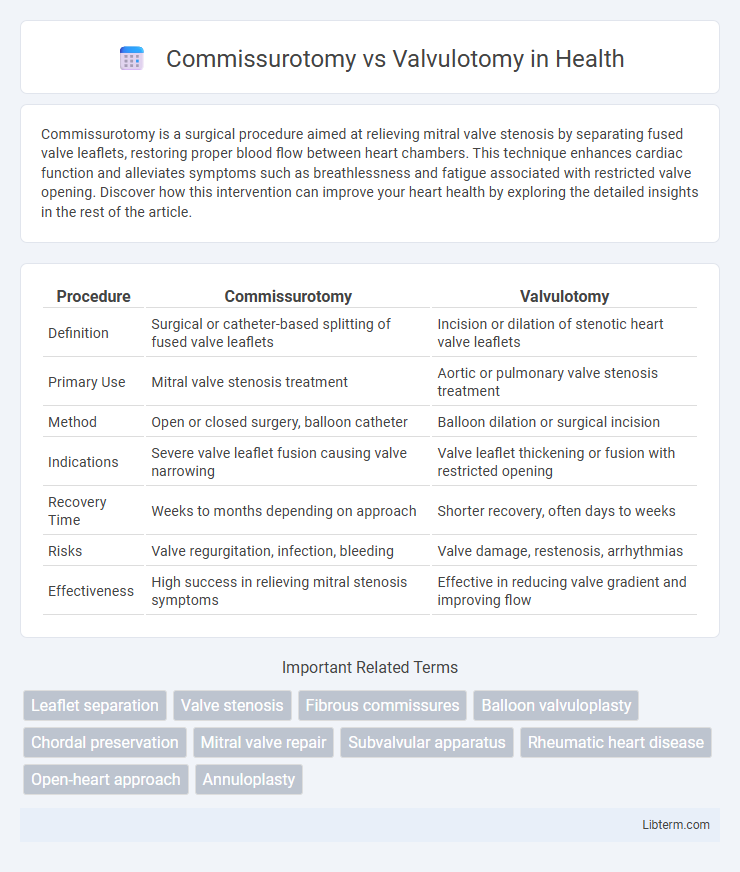Commissurotomy is a surgical procedure aimed at relieving mitral valve stenosis by separating fused valve leaflets, restoring proper blood flow between heart chambers. This technique enhances cardiac function and alleviates symptoms such as breathlessness and fatigue associated with restricted valve opening. Discover how this intervention can improve your heart health by exploring the detailed insights in the rest of the article.
Table of Comparison
| Procedure | Commissurotomy | Valvulotomy |
|---|---|---|
| Definition | Surgical or catheter-based splitting of fused valve leaflets | Incision or dilation of stenotic heart valve leaflets |
| Primary Use | Mitral valve stenosis treatment | Aortic or pulmonary valve stenosis treatment |
| Method | Open or closed surgery, balloon catheter | Balloon dilation or surgical incision |
| Indications | Severe valve leaflet fusion causing valve narrowing | Valve leaflet thickening or fusion with restricted opening |
| Recovery Time | Weeks to months depending on approach | Shorter recovery, often days to weeks |
| Risks | Valve regurgitation, infection, bleeding | Valve damage, restenosis, arrhythmias |
| Effectiveness | High success in relieving mitral stenosis symptoms | Effective in reducing valve gradient and improving flow |
Introduction to Commissurotomy and Valvulotomy
Commissurotomy is a surgical procedure primarily used to treat mitral valve stenosis by incising the fused commissures of the valve to restore normal blood flow. Valvulotomy, on the other hand, involves cutting the valve leaflets or cusps to relieve narrowing or obstruction, often performed on various heart valves such as the aortic or pulmonary valves. Both procedures aim to improve valve function and hemodynamics but differ in their surgical approach based on the valve pathology involved.
Indications for Commissurotomy
Commissurotomy is primarily indicated for patients with mitral valve stenosis caused by rheumatic heart disease when valve leaflets are thickened but still pliable, without significant calcification or subvalvular fibrosis. This procedure is most effective in cases where there is commissural fusion leading to restricted valve opening, improving valve area and blood flow. Unlike valvulotomy, which may be used to relieve stenosis in other valves, commissurotomy specifically targets fused commissures to restore leaflet mobility.
Indications for Valvulotomy
Valvulotomy is primarily indicated for patients with valvular stenosis, particularly those with mitral or aortic valve narrowing that restricts blood flow and causes symptomatic heart dysfunction. This procedure is often chosen when the valve leaflets are thickened or fused but remain pliable enough to allow successful surgical splitting or balloon dilation. In contrast, commissurotomy is generally preferred for cases where the valve commissures are fused, commonly seen in rheumatic mitral stenosis, making valvulotomy less effective.
Surgical Techniques: Commissurotomy Explained
Commissurotomy involves precise incision of fused valve commissures to restore leaflet mobility, commonly used in treating mitral or aortic valve stenosis. This surgical technique requires careful separation of the fused leaflets without damaging the valve structure, effectively increasing valve orifice area. Compared to valvulotomy, which directly incises the valve leaflet itself, commissurotomy targets the commissural fusion point to improve valve function while preserving leaflet integrity.
Surgical Techniques: Valvulotomy Explained
Valvulotomy is a precise cardiac surgical technique that involves incising fused heart valve leaflets to restore valve function, commonly used in treating stenotic mitral or aortic valves. The procedure enhances leaflet mobility without removing valve tissue, preserving the native valve structure and promoting improved hemodynamics. Compared to commissurotomy, which targets the fusion at valve commissures, valvulotomy directly addresses the leaflet thickening and calcification that causes restricted valve opening.
Comparative Efficacy: Outcomes and Success Rates
Commissurotomy and valvulotomy are surgical procedures used to treat valvular heart diseases, with commissurotomy primarily addressing mitral valve stenosis by separating fused valve leaflets, while valvulotomy targets valve leaflet thickening or obstruction. Clinical studies demonstrate that commissurotomy generally yields higher success rates in restoring valve function and improving hemodynamics, particularly in patients with less calcified valves, compared to valvulotomy which may be more suitable for localized leaflet lesions. Long-term outcomes show commissurotomy is associated with lower rates of restenosis and better functional status, though patient selection and valve pathology remain critical determinants of procedural efficacy.
Risks and Complications of Commissurotomy
Commissurotomy, a surgical procedure to separate fused heart valve leaflets, carries risks such as valve regurgitation, thromboembolism, and arrhythmias. Potential complications include damage to the valve structures, leading to stenosis or insufficiency, and increased risk of infective endocarditis post-procedure. In contrast, valvulotomy, which involves incising valve leaflets to relieve stenosis, generally presents fewer risks of severe valve damage but may result in residual stenosis or incomplete symptom relief.
Risks and Complications of Valvulotomy
Valvulotomy carries risks such as bleeding, infection, and damage to surrounding heart tissues, potentially leading to arrhythmias or valve insufficiency. Unlike commissurotomy, valvulotomy may have a higher incidence of restenosis and valve leaflet tearing. Careful patient selection and advanced imaging techniques are essential to minimize complications and improve procedural outcomes.
Patient Selection Criteria and Decision-Making
Patient selection criteria for commissurotomy prioritize candidates with severe mitral valve stenosis exhibiting commissural fusion without significant calcification or subvalvular involvement, ensuring optimal valve mobility restoration. Valvulotomy is preferred for patients with tricuspid or pulmonary valve stenosis where commissural fusion is less pronounced, and leaflet thickening or fibrosis is the primary obstacle to valve opening. Decision-making relies on detailed echocardiographic assessment, symptom severity, valve anatomy, and presence of comorbidities to choose the procedure that maximizes hemodynamic improvement and minimizes procedural risks.
Future Trends in Heart Valve Surgery
Future trends in heart valve surgery emphasize minimally invasive techniques, including percutaneous commissurotomy for mitral valve stenosis and advanced valvulotomy approaches for aortic valve repair. Innovations in imaging technologies and robotic-assisted surgery enhance precision and patient recovery times, promoting personalized treatment strategies. Research on tissue-engineered valve replacements and valve-sparing procedures aims to reduce complications and improve long-term durability.
Commissurotomy Infographic

 libterm.com
libterm.com